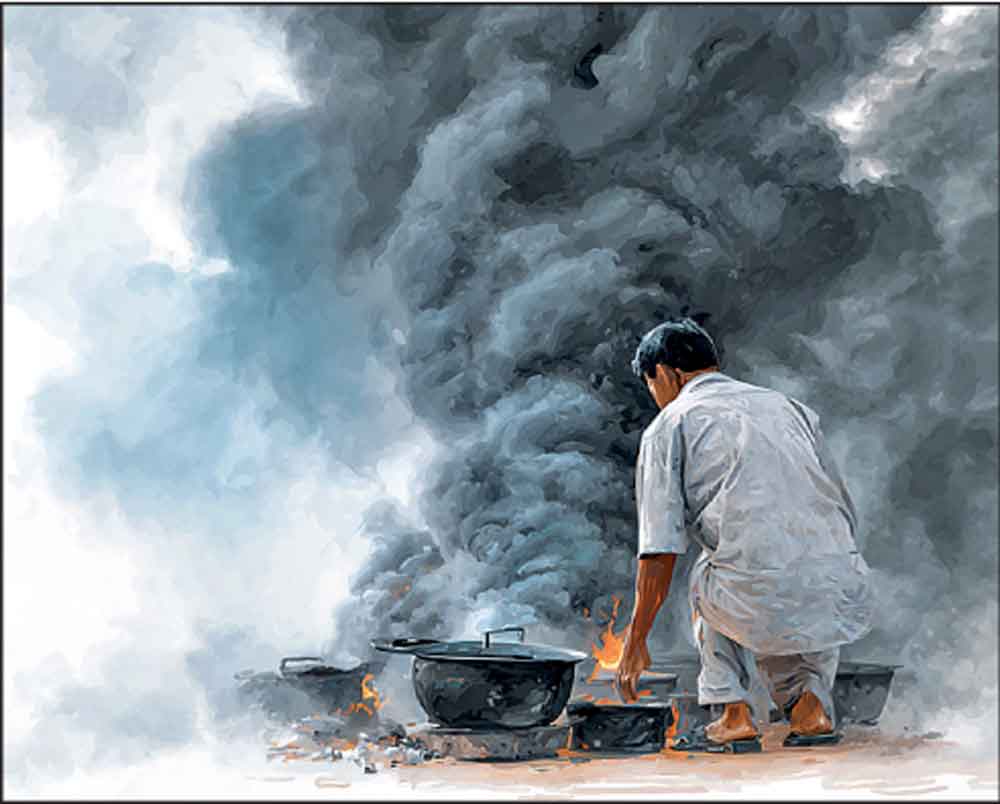Tuesday Dec 23, 2025
Tuesday Dec 23, 2025
Saturday, 26 July 2025 00:05 - - {{hitsCtrl.values.hits}}

Action on black carbon offers significant opportunities for double impact on addressing the climate-health nexus
 Short-lived climate pollutants (SCPs), also known as super pollutants, have contributed to almost half of global warming to date and play an outsized role in pushing Earth toward dangerous tipping points. One of these pollutants, black carbon—fine particulate matter resulting from incomplete combustion, such as in cookstoves, diesel engines, or waste burning—offers significant opportunities for double impact on addressing the climate-health nexus. Its dual identity as a potent climate forcer and air pollutant places black carbon at the intersection of climate change mitigation and public health.
Short-lived climate pollutants (SCPs), also known as super pollutants, have contributed to almost half of global warming to date and play an outsized role in pushing Earth toward dangerous tipping points. One of these pollutants, black carbon—fine particulate matter resulting from incomplete combustion, such as in cookstoves, diesel engines, or waste burning—offers significant opportunities for double impact on addressing the climate-health nexus. Its dual identity as a potent climate forcer and air pollutant places black carbon at the intersection of climate change mitigation and public health.
Black carbon across key sectors
Black carbon matters. Due to its potent contribution to global warming, it has an outsized impact on climate change but is not typically included in national greenhouse gas reporting under the UNFCCC. As an air pollutant, it also poses serious risks to human health through cardiovascular and respiratory diseases as well as its contribution to the millions of premature deaths due to air pollution each year. Beyond these direct impacts on climate and health, black carbon also has direct and indirect impacts on ecosystems, livelihoods, and the environment, such as the disruption of monsoon patterns and its role in intensifying extreme weather events, including floods, droughts, and heatwaves.
As outlined above, black carbon emissions stem from the incomplete combustion of biomass, waste, and fossil fuels, connecting them mainly to the residential (cooking, heating, lighting), transport, industry, agriculture, and waste management sectors. Near the source of emission, black carbon also creates heat island effects, which accelerate warming and influence ecosystems, climate systems, and regional weather patterns. The exact sources of black carbon vary between regions, but for South Asia, the residential sector is by far the biggest source of black carbon (60%), followed by industry (17%), transport (10%), and waste.
In the residential sector, traditional biomass cookstoves and open fire are major sources of black carbon in South Asia, often disproportionately affecting women and children. Industrial facilities, such as brick kilns, coke ovens, and coal‑fired plants, are main contributors that are often clustered near low‑income communities. Heavy‑duty diesel engines, two‑stroke motorcycles, and the open burning of municipal solid waste as well as agricultural residue also play a significant role.
Low‑hanging fruit: Mitigating black carbon emissions
In its Special Report on Global Warming of 1.5°C, the Intergovernmental Panel on Climate Change (IPCC) highlights the fact that deep reductions in black carbon emissions are a key part of any pathway to limit global warming to 1.5°C with no or limited overshoot. In addition to black carbon mitigation as an important area for scaling up climate action, it also offers a range of health, environmental, and economic benefits. Due to its short-lived nature and the available suite of proven interventions, black carbon action can lead to quick and easy wins and accelerate progress towards the sustainable development targets as well as a just transition to clean and resilient economies.
Such interventions include, for example, transition to clean cooking technologies, renewable energy, and grid or off-grid solar lighting in the residential sector. In industry and transport, transitions from traditional models to more efficient technologies could entail cleaner shipping fuels or emission control standards that regulate particle number for vehicles, especially high-emitting heavy duty ones. Furthermore, holistic waste management plans, prevention of open burning of municipal solid waste, crop residue management machinery, and curbing of crop residue burning are among the other well-tested interventions for addressing black carbon. Embedding black carbon metrics in national air quality standards and climate reporting could help to create disaggregated data on sectoral emissions and population exposure hotspots for targeted action.
Regionally, coordinating black carbon inventories and monitoring mitigation could help to harmonise methodologies, enable performance benchmarking, and foster peer learning. As black carbon interventions require upfront investment and enabling policies, there is also an important role for climate funds, multilateral development banks, and bilateral donors in providing support for scaling up relevant programmes and de-risk private sector investment in clean technologies, particularly for small‑scale enterprises and entrepreneurs (such as those supplying cookstoves and retrofits). Furthermore, public–private partnerships or a blended finance facility could help to mobilise capital at scale and ensure that interventions can be effectively implemented.
The way forward
Globally, there is an increasing awareness and momentum for addressing black carbon. Integrating specific targets on black carbon targets into the next round of Nationally Determined Contributions (NDCs)—which are due this year—presents an entry point that could help countries make their commitments more visible and measurable. So far, more than a dozen countries have referenced black carbon mitigation in their NDCs, but this number is set to rise as more NDCs are updated and completed.
Reducing black carbon also accelerates progress on the Sustainable Development Goals related to health (SDG 3), clean energy (SDG 7), sustainable cities (SDG 11), and climate action (SDG 13). Framing interventions through a health‑in‑all‑policies lens could further galvanise cross‑sectoral collaboration, engaging ministries of health, environment, energy, industry, transport, and urban development.
Addressing black carbon offers a chance for double impact on climate change and air pollution, benefitting people as well as the environment. There is potential to harness co-benefits and synergies through holistic and evidence-based strategies that bring together climate and health, addressing multiple elements of the triple planetary crisis at the same time. Investing in low‑hanging black carbon mitigation today can build momentum towards deeper decarbonisation and a cleaner environment tomorrow.
(The writer works as Director: Research & Knowledge Management at SLYCAN Trust, a non-profit think tank. His work focuses on climate change, adaptation, resilience, ecosystem conservation, just transition, human mobility, and a range of related issues. He holds a Master’s degree in Education from the University of Cologne, Germany and is a regular contributor to several international and local media outlets.)